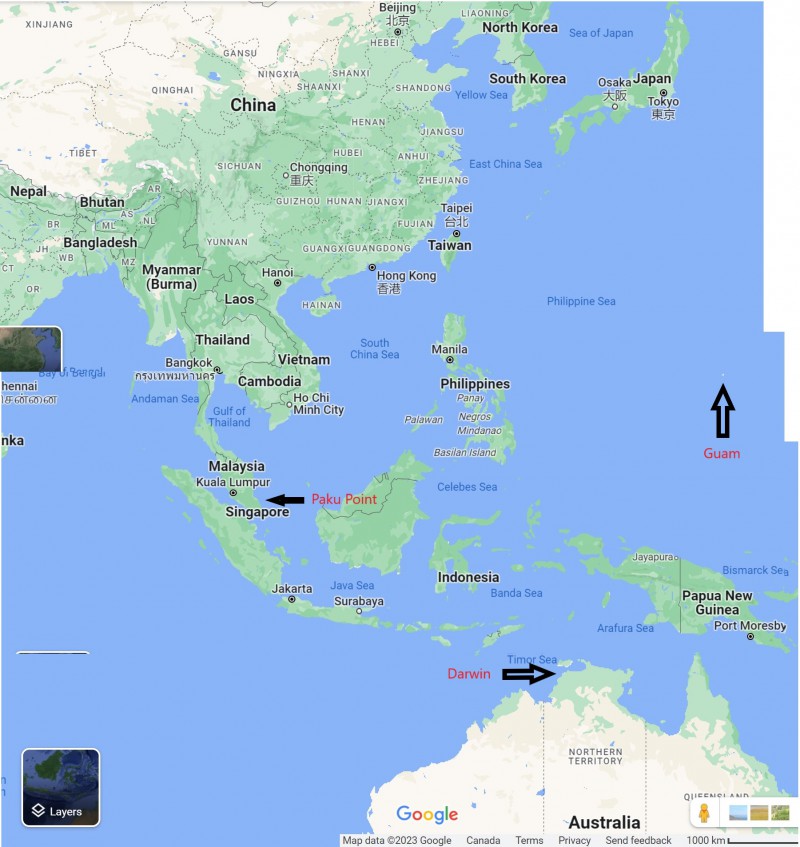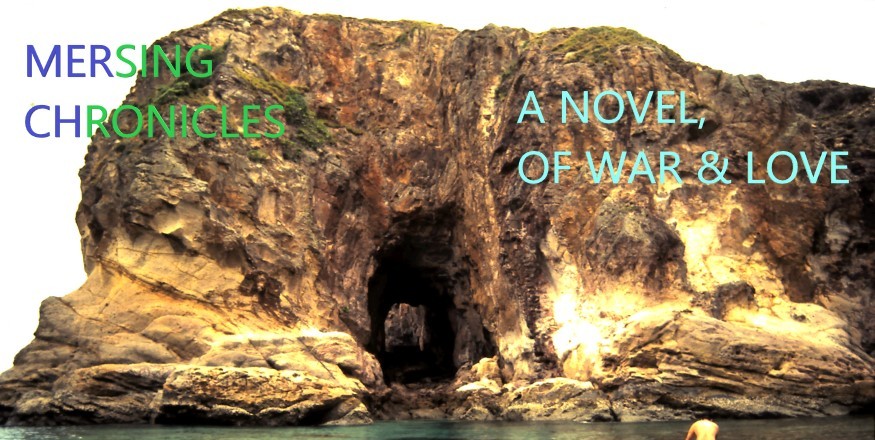 x
x
How China won World War III
by Evelyn Lee Ji Hiang, Singapore Times, March 2, 2075
Perhaps it was only within an autocratic system that a victor could win WW III. After all what democratic nation in the world could authorize the expenditure of 4 trillion US dollars over 20 years to build a first strike weapons system that no one could see until there was an actual conflict of global proportions.
On April 6, 2050, China demonstrated its stealth weapons capability by revealing 12 submarine aircraft carriers of 100,000 ton each (equivalent to a conventional US aircraft carrier) at three different locations: Mersing, Malaysia; Manila, Phillipines; and Darwin, Australia. Simultaneously, Chinese forces invaded Taiwan and toppled the Taiwanese government in 10 days. Absent US forces, Taiwan didn't stand a chance.
It was a surprise to the Western Alliance in every sense of the word.
The author witnessed the carriers in action while on an island off Mersing in the early days of the war. It's aircraft consisted of the 6th generation VTOL fox which could match the F35s in maneuverability, and speed. With an armada of 4 submarine carriers and 2 Japanese heavy cruisers, with destroyer escorts, it managed to fend off wave after wave of F35 sorties and Jassmer air to ship missiles with damage to only one carrier. The carrier was able to maintain combat capability and remained in the theatre for a few weeks before it was sent back to base for repairs.
The carriers were a game changer the Western Alliance had not seen or imagined possible. Their wargaming on computers and in real life did not have submarine carriers appearing from nowhere to provide air cover to invading armadas.
When the war started, there were only three carrier task forces the US had in the Western Pacific, the 7th fleet in the South China Sea, the 10th fleet off Papua New Guinea and the 12th fleet near Guam. All three were engaged in the early days of the war, the 7th and 12th fleet at Manila, the 10th fleet at Darwin. Two carrier task forces were held in reserve at Hawaii, and it took a full four days before they could engage the invasion forces. All in the Chinese had 12 carriers in the first day of invasion versus the American's three. It was a crapshoot. All three invasion spots created a beachhead on the second day and they expanded their territory for the duration of the war. Singapore and Malaysia were taken out of the equation when their capitals fall on August 10th 2050, and September 3, 2050 respectively. Manila was evacuated on June 5th, 2050 with the Phillipines forces retreating to Mindanao island. The remaining ASEAN states which had no US alliances or were pro-China were left alone.
The two reserve task forces, the 2nd and 4th fleets from Hawaii were sent to Darwin and effectively halted further incursion into Australian territory creating a frontline at the Gold Coast which remained for the duration of the war.
How was it possible for the Chinese to have kept secret their monumental first strike weapons from the West for the years they were in development, testing, and commissioning. How do you keep 12 submarine carriers each the size of a conventional US aircraft carrier hidden from satellite for over a decade?
273Please respect copyright.PENANA3Qb4xkVwaZ
How did they do it?
The Chinese repeated an achievement equivalent to the building of the Great Wall of China, or in the modern sense, the equivalent of successfully landing a manned mission on Mars and returning them home. They built an underground cavern 6 km long by 4 km wide and 2000 foot deep which they filled with water to create a gargantuan underground lake where they built, tested, and commissioned their subcarriers.
From diverse sources, inside and outside the Chinese military, as well as from US government sources, a picture has emerged of how this was achieved. Located 3000 foot deep within a granite mountain range (some say it could have been the Yellow Mountain, but this was not confirmed) a few hundred km from the coast, China carved out this cavern over 10 years. It started with drilling a large tunnel to a depth of 3000 foot. The tunnel was large enough to fit in a 4-lane highway. Then starting with large tunneling drills used for subway constructions they created a vertical arc-shaped tunnel stretching 4 km in a horizontal distance from end to end at this depth of 3000 foot. The arcs were concaved downwards and large enough to fit in a 2-lane highway. Prefabricated molds were then installed to create a formwork complete with the traditional metal rebars. In addition to the rebars, the formworks enclosed around 20 polypropylene pipes of 15-inch diameter stretching the length of the arc. Concrete were then poured in. Once hardened, one foot diameter steel cables were inserted into the pipes stretching the length of the arc. The steel cables were then tightened at both ends so they remain permanently stressed. The concept is a civil engineering technology created in the 20th century used commonly in conventional buildings called post-tensioning. These stretched and tightened cables create a permanent compressive force along the length of the concrete arc. With the concrete arc concaved downwards and compressed through the length of the arc, it serves to support the downward weight of the granite above the arc. These concrete arcs were created in parallel at a distance of around 30 m apart along the 6 km length of the cavern. These ribs of concrete arcs were the beginnings of the roof. There were around 150 of these concrete arcs in parallel. Once this roof was done, the process to carve out the granite below the roof began. The downward carving out of the cavern was a painstaking process as no explosives were used to preserve the integrity of the roof. The carving out of the 2000-foot depth of the 6 km by 4 km cavern starting from the roof took a total of 7 years. Concurrent to the construction of the cavern were the construction of 8 large tunnels from the surface to the cavern that were intended to supply ventilation to the cavern. To maintain an independent power supply, three nuclear reactors were built underground with 300% redundancy close to the caverns. Water filled up the cavern to a depth of 1000 foot.
It took a further 10 years to construct, test, and commission the 12 subcarriers within this cavern. All operational training and wargame exercises were conducted within this underground lake.
How were the subs able to get to the coast?
The CIA believe an underground canal was built that allowed the subs to reach the coast and then the open sea. It is believed a series of airlock systems were built to allow the air pressure to gradually normalize to the outside pressure as the sub emerged from 3000-foot underground.
273Please respect copyright.PENANAaHOoj86z45
Geopolitics post WW3
The South Korean government was the second government to fall after Taiwan. It capitulated after 2 weeks from coordinated attacks from the North Koreans and Chinese forces. Korea is now a united country under a communist system modelled after that of China. The Kim dynasty had been removed after the war as they no longer serve as a buffer between China and South Korea.
The Chinese nine dash line demarcating the South China Sea as China's territorial waters is now internationally recognized. Western navies no longer conduct right-of-way passage into these waters, although commercial vessels are not restricted from entering these waters.
Japan remains a democratic country aligned with China with close economic ties.
Singapore and Malaysia remain independent sovereign states to a certain extent. However, they owe suzerainty to the Chinese government, a practice which had its history from the Ming Dynasty of the 1400s. The Ming Dynasty which ruled China from 1368 to 1644 launched seven armadas of several hundred ships each between 1405 and 1433. Each voyage was led by the eunuch Admiral Zheng He. In one such voyage, they encountered resistance from the Ceylonese King (modern day Sri Lanka) and a fight ensued which resulted in the capture of the Ceylon capital. Thereafter, the Ceylon King was deposed and replaced with a King who was acceptable to China. The new King had to send an annual tribute of gold and precious stones to the Chinese emperor as a mark of respect. Something similar has been arranged with Singapore and Malaysia. Although sovereign states, their Head of States are required to travel to Beijing annually with their respective Prime Ministers as a "show of respect". Their constitutions were amended to reflect this mandatory condition.
The Phillipines and Australia has a different arrangement. Their governments were not toppled or defeated. However, to end the war, the Chinese treaty of peace with the Americans required them to limit their weapons purchases from the Americans to 1 US billion a year, a paltry sum.
The world in the Far East has degenerated to the early 20th century where colonial powers had spheres of influence. China's sphere of influence in the late 21st century stretches from Myanmar in the west to Japan in the east, from Japan in the north to Australia and New Zealand in the south.
And what became of nuclear weapons? It was never used during World War 3. There was the mutual threat that the use of nuclear weapons against one side would elicit a response in kind. If you nuke one of our city, we will nuke one of your city in return. Such a threat guaranteed neither side would resort to such weapons.
273Please respect copyright.PENANABM1YFRRcpR























